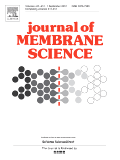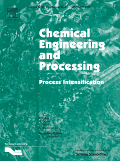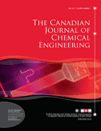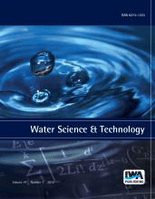
JOURNAL OF MEMBRANE SCIENCE
Scope & Guideline
Unleashing Breakthroughs in Separation Processes
Introduction
Aims and Scopes
- Membrane Fabrication Techniques:
Research on innovative methods for constructing membranes, including interfacial polymerization, electrospinning, and 3D printing, which aim to enhance membrane performance and reduce production costs. - Membrane Characterization and Modeling:
Studies involving the characterization of membrane properties and performance through experimental methods and simulations, contributing to a deeper understanding of transport phenomena. - Separation Processes and Applications:
Exploration of various separation processes utilizing membranes for applications in water treatment, gas separation, and the purification of pharmaceuticals, emphasizing efficiency and sustainability. - Fouling and Cleaning Mechanisms:
Investigation of fouling phenomena in membrane processes, including the development of antifouling strategies and cleaning protocols to enhance membrane longevity and performance. - Sustainable and Green Chemistry:
Research aimed at developing environmentally friendly membrane materials and processes, including the use of renewable resources and reducing chemical waste during membrane production. - Advanced Functional Membranes:
Development of membranes with tailored functionalities, such as self-cleaning, antibacterial properties, and selective ion transport capabilities, to meet specific application needs.
Trending and Emerging
- Hybrid and Composite Membranes:
There is a notable increase in research on hybrid and composite membranes that combine different materials to achieve enhanced performance characteristics, such as improved selectivity and mechanical stability. - Nanomaterials in Membrane Technology:
The incorporation of nanomaterials, such as graphene oxide and metal-organic frameworks, into membrane structures is a growing trend, aiming to enhance permeability and fouling resistance. - Smart and Responsive Membranes:
Development of membranes that respond to external stimuli (e.g., pH, temperature) for selective separation processes is gaining traction, showing potential for advanced applications. - Membrane Processes for Energy Recovery:
Research focusing on membrane processes that enable energy recovery, such as pressure retarded osmosis and forward osmosis, is on the rise, reflecting a shift towards sustainable practices. - Membrane Bioreactor Systems:
The integration of membrane technology with bioreactor systems for wastewater treatment and resource recovery is increasingly popular, driven by the need for efficient and sustainable solutions. - Machine Learning and AI Applications:
The use of machine learning and artificial intelligence for predicting membrane performance and optimizing membrane processes is emerging as a significant trend, improving research efficiency.
Declining or Waning
- Traditional Membrane Materials:
Research on conventional membrane materials such as cellulose and polysulfone appears to be decreasing, as newer materials like MOFs and COFs gain prominence due to their superior properties. - Basic Membrane Theory:
Papers that focus solely on the theoretical aspects of membrane science without practical application or experimental validation are less frequent, as there is a shift towards applied research. - Single-Use Membrane Technologies:
The focus on single-use or disposable membranes is waning as the industry moves toward more sustainable and reusable membrane technologies. - Low-Temperature Applications:
Studies centered on low-temperature applications for membranes, particularly in gas separation, are less prevalent, as research trends shift toward high-temperature and extreme conditions.
Similar Journals

Journal of Industrial and Engineering Chemistry
Pioneering Research in Industrial ChemistryThe Journal of Industrial and Engineering Chemistry, published by Elsevier Science Inc, stands as a premier platform since its inception in 1996, dedicated to the dissemination of innovative research in the field of Chemical Engineering. Located in South Korea, this influential journal has established itself with an impressive impact factor and is categorized in the Q1 quartile for chemical engineering (miscellaneous), ranking in the top 12% of its category according to Scopus. With a focus on cutting-edge industrial applications, the journal covers a diverse range of topics including chemical processes, engineering innovations, and sustainable practices, appealing to a broad spectrum of researchers, professionals, and students. Although currently not open access, the journal offers a wealth of resources for advancing knowledge and driving forward the chemical engineering discipline. The converged years from 1996 to 2024 reflect its ongoing commitment to excellence and timeliness in publishing high-quality research.

Membranes and Membrane Technologies
Advancing Membrane Science for a Sustainable TomorrowMembranes and Membrane Technologies is an innovative journal dedicated to advancing the fields of chemical engineering, chemistry, and materials science through the exploration of membrane science and technology. Published by PLEIADES PUBLISHING INC, this journal offers vital insights into the efficient design, synthesis, and application of membranes across diverse industries, aiming to enhance water treatment, energy generation, and various separation processes. With an ISSN of 2517-7516 and an E-ISSN of 2517-7524, the journal is recognized for its impactful contributions, holding a Q3 category ranking in multiple fields as of 2023. Researchers and professionals will find a wealth of open-access articles that promote the sharing of knowledge and foster collaboration in this rapidly evolving domain. As it converges its mission from 2019 to 2024, Membranes and Membrane Technologies remains an essential resource for those committed to pushing the frontiers of membrane research and application.

Biochemistry Moscow Supplement Series A-Membrane and Cell Biology
Innovating Insights into Membrane DynamicsBiochemistry Moscow Supplement Series A-Membrane and Cell Biology, published by PLEIADES PUBLISHING INC in the United States, is a pivotal journal in the fields of biochemistry, biophysics, and cell biology. Established in 2008, this journal has become a significant platform for disseminating novel research findings and reviews, fostering advanced studies in membrane dynamics and cellular processes. Although currently ranked in the Q4 quartile across its categories, the journal provides researchers and professionals with open access to a wealth of knowledge, helping to bridge gaps in understanding complex biochemical mechanisms. The journal’s commitment to quality and relevance is evident as it continues to contribute to the academic community through its coverage of innovative and emerging topics in cell and membrane biology. Researchers, practitioners, and students alike will find this resource invaluable for keeping abreast of the latest developments in the ever-evolving landscape of biochemistry and cellular research.

NATION
Empowering critical discourse in Social Sciences.NATION is a prestigious and influential journal that has been serving the field of Social Sciences and Cultural Studies since its inception. Published by NATION CO INC, this journal offers a platform for innovative research and critical discourse, empowering scholars to explore the complexities of culture, politics, and society. Although currently not an open-access publication, NATION remains a significant resource for researchers and practitioners aiming to stay abreast of the latest developments in the field. With a history of converging years of publication and a notable ranking of #796 out of 1002 in the Scopus Social Sciences_Cultural Studies category—with a percentile of 20%—the journal's contributions continue to play a vital role in academic discussions and cultural critiques. The editorial office is located at 33 Irving Place, 8th Floor, New York, NY 10003, facilitating a dynamic interaction between contributors and the editorial team. By engaging with this journal, academics and professionals can enrich their understanding of crucial cultural phenomena.

Chemical Engineering and Processing-Process Intensification
Advancing the Frontiers of Process IntensificationChemical Engineering and Processing - Process Intensification is a leading journal published by Elsevier Science SA, specializing in the multifaceted domain of chemical engineering. With the ISSN 0255-2701 and E-ISSN 1873-3204, this journal stands as a beacon of knowledge, facilitating the dissemination of innovative research from 1984 onwards and continuing through 2024. Renowned for its rigorous peer-review process, it boasts a distinguished reputation, reflected in its top-tier rankings within several fields: Q1 in Chemical Engineering (Miscellaneous), Q2 in Chemistry, and Q1 in Industrial and Manufacturing Engineering. This journal focuses on the advancements in process intensification, which are crucial for optimizing efficiency and sustainability in chemical processes. Although access is not open, the journal serves as an essential resource for researchers, professionals, and students alike who seek to advance their understanding and contribute to the evolving landscape of chemical engineering and process technology. Join a community of innovators driving the future of process engineering through impactful and cutting-edge research.

SEPARATION AND PURIFICATION TECHNOLOGY
Pioneering research in separation and purification technologies.SEPARATION AND PURIFICATION TECHNOLOGY is a leading multidisciplinary journal published by Elsevier, focused on advancing the fields of Analytical Chemistry and Filtration and Separation. With its ISSN 1383-5866 and E-ISSN 1873-3794, this prestigious journal has achieved remarkable recognition, ranking in the top quartile (Q1) in both its categories, reflecting its substantial impact and relevance in the scientific community. Operating from its headquarters in Amsterdam, Netherlands, SEPARATION AND PURIFICATION TECHNOLOGY serves as a vital platform for researchers, professionals, and students to disseminate innovative findings and methodologies related to separation processes and purification techniques. The journal not only promotes open access research but also maintains a rigorous peer-review process to ensure high-quality publications. With a convergence period spanning from 1997 to 2025, it highlights the ongoing evolution and importance of separation technology in various applications, establishing it as an essential resource for those interested in cutting-edge advancements in analytical and chemical engineering domains.

Bioelectricity
Pioneering Research at the Intersection of Biology and TechnologyBioelectricity, published by MARY ANN LIEBERT, INC, is an esteemed journal dedicated to the interdisciplinary field that bridges biomedical engineering and electrical engineering, promoting research and innovation in the use of electrical signals for biological applications. Since its inception in 2019, the journal has established a solid reputation within the academic community, evidenced by its categorization in the Q3 quartile for Biomedical Engineering, Electrical and Electronic Engineering, and Medicine, alongside a notable Q2 ranking in Transplantation for 2023. With an ISSN of 2576-3105, Bioelectricity serves as a pivotal platform for disseminating cutting-edge research and fostering advancements in technology and medicine, drawing contributions from scholars globally. Although the journal operates under a traditional access model, it remains a critical resource for researchers, professionals, and students keen on exploring the potential of bioelectric phenomena in medical treatments and devices. As the field continues to evolve, Bioelectricity plays a vital role in shaping discussions and insights that propel innovations in health and engineering.

CANADIAN JOURNAL OF CHEMICAL ENGINEERING
Delivering Insightful Perspectives in Chemical EngineeringCanadian Journal of Chemical Engineering, published by Wiley, stands as a pivotal platform in the field of chemical engineering, addressing a myriad of topics essential for researchers, professionals, and students alike. With ISSN 0008-4034 and E-ISSN 1939-019X, this journal has been a cornerstone of chemical engineering scholarship since its inception in 1958 and continues to provide valuable insights through its rigorous peer-reviewed articles. The journal is ranked in the Q2 category of the Scopus quartile rankings, reflecting its influence and relevance within the chemical engineering community, with a notable position of #137 out of 273 in the general chemical engineering field. Although it does not offer open access options, its comprehensive coverage of contemporary research and applications solidifies its status as a vital resource for advancing knowledge and innovation in chemical engineering.

Membranes
Pioneering breakthroughs in membrane research and applications.Membranes, published by MDPI since 2011, is an esteemed open access journal dedicated to advancing the field of membrane science and technology. With an E-ISSN of 2077-0375, this journal serves as a vital platform for researchers and professionals from various disciplines such as chemical engineering, filtration, and separation technologies. Holding a commendable Q2 ranking in Chemical Engineering (miscellaneous) and notable placement in filtration and process chemistry categories, it provides a robust framework for researchers to disseminate groundbreaking findings. The journal's commitment to open access ensures a wide-reaching impact, allowing for unrestricted sharing of high-quality research that addresses the critical challenges and innovations in membrane technology. Situated in Switzerland, Membranes is not only a cornerstone for academic inquiry but also a leading resource for students and industry experts seeking cutting-edge developments in their fields.

WATER SCIENCE AND TECHNOLOGY
Pioneering advancements in environmental engineering and water resource management.WATER SCIENCE AND TECHNOLOGY, published by IWA PUBLISHING, is a leading academic journal dedicated to advancing the field of water science and technology. With a rich history dating back to 1970, the journal provides a platform for innovative research and technological advancements, catering to the vital challenges faced within the realms of environmental engineering and water resource management. As evidenced by its strong ranking in Scopus, where it holds a position of #86 in Water Science and Technology and #77 in Environmental Engineering, the journal exemplifies significant scholarly contributions, reflected in its Q2 quartile status in both categories as of 2023. Although not an open access journal, WATER SCIENCE AND TECHNOLOGY ensures that its articles are widely available to researchers, professionals, and students passionate about sustainable water solutions. With a continued commitment to excellence, this journal plays a crucial role in shaping the discourse surrounding water quality, conservation, and technology innovation, making it an essential resource for all stakeholders in this critical field.